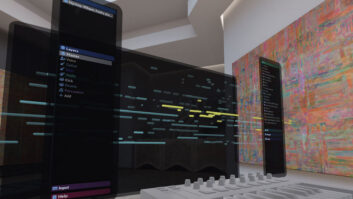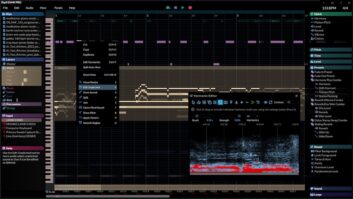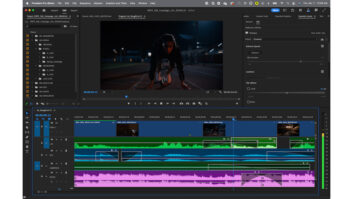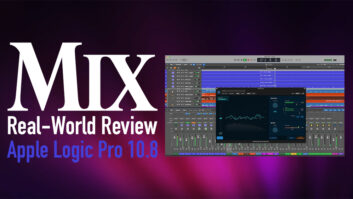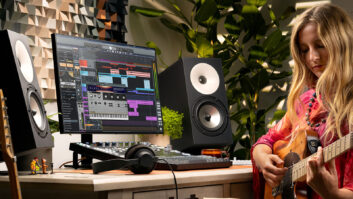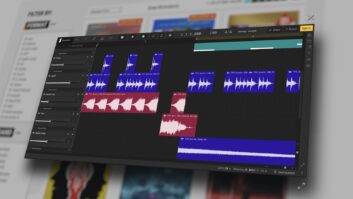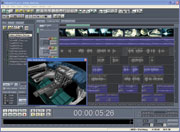

Recent acquisitions of audio companies by much larger video companies have made some unusual bedfellows. Arguably, the company that has done the most with the least is Adobe. It took Cool Edit Pro — a very cool, inexpensive and fairly intuitive DAW that introduced a lot of entry-level audio enthusiasts to digital recording — and turned it into Adobe Audition. The latest version, Adobe Audition 1.5 (PC-only), is an improved, all-around recording, editing and mixing environment for audio and film post-production. It is capable of 128 tracks and supports standard sampling rates including 192 kHz. The best part is that, at $299, it is still accessible to those with even modest budgets.
Adobe Audition 1.5 allows video file import and integrates with Premier, After Effects and Encore DVD.
EFFORTLESS INSTALL
For the test, I used a 2.4GHz Pentium 4 with 512 MB of RAM running Windows XP Pro. After an easy and glitch-free install, I instantly noticed how well-organized the interface was. If you don’t like the layout, just about every panel can be resized and has docking capabilities — an excellent feature for setups with dual monitors.
At first, I was planning on using a Digidesign 002R for I/O, but that quickly changed as Audition 1.5 couldn’t detect my 002R hardware. After a quick read of the manual, I was disappointed to find that Audition 1.5 does not support ASIO drivers. Plan B was to ask MOTU to lend us its excellent 828mkII for the review, which worked wonderfully.
NEW FEATURES FOR 1.5
An impressive new feature in Audition 1.5 is the introduction of frequency space editing. With Adobe’s Marquee Selection tool, you can make frequency-specific selections within Audition’s Spectral View. (Instead of your usual time vs. amplitude graph, it’s time vs. frequency.) This enables the user to apply any effect or dynamic processing on any or multiple bands of frequencies while leaving others unaffected.
I used this approach on a live string ensemble where there was some coughing in the audience. Once in Spectral View, the coughing was quite obvious to the eye: Spectral View has a dark purple background with the program material ranging from a bright orange to a pinkish display. I made a quick selection of the obtrusive coughs with the Marquee Selection tool. Then, under Favorites, I selected Repair Transient, applied a little amplify/fade tweak and the coughing was gone. Audition 1.5 was able to remove about 90 percent of the interfering sound. Audition 1.5 also provides access to frequency and phase analysis windows, which is helpful. I spent much of my time within the Spectral View as it was functional and a very creative tool.
RESTORATION AND PITCH-FIXING
Audition 1.5 provides you with a complete set of restoration tools right out of the box. A new Auto Click/Pop Eliminator offers a speedy option to the Standard Click/Pop Eliminator that’s been around since V.1.0. By just using the presets, I was able to easily clean up DV camera noises, a live recording and noisy vinyl transfers. I also tried it on an older recording that had a bad digital clocking tick and it worked without changing any of the dynamics. Fully tweakable restoration tools that are available include manual Click/Pop Eliminator, Clip Restoration, Noise Reduction and Hiss Reduction.
A pitch-correction tool comes standard in 1.5. The interface is broken down into a user-friendly automatic mode and a more in-depth manual mode. In auto mode, you define the key, adjust the sensitivity and the attack time, and Audition 1.5 analyzes and adjusts the pitch. In manual mode, you can make precise adjustments, note by note. You can easily draw in the pitch corrections along a timeline with a graphical view of the waveform.
For this review, Adobe provided Propeller-heads Reason to demo the new ReWire support in 1.5. ReWire allows multiple programs to communicate with one another and stream full-resolution data in real time. There is a new ReWire tab under Device Properties that, once enabled, feeds the outputs of ReWire to an input in Audition 1.5. During my ReWire session, synchronization was constant between Reason and Audition 1.5, regardless of which transport I used.
VIDEO-READY
Adobe has built some impressive video ability into Audition. Easily integrating Audition 1.5 with Adobe’s Premiere, After Effects and Encore DVD gives anyone the ability to complete any A/V project from start to finish. By importing video files such as .AVI, DV and .MPEG and taking advantage of the timecode capabilities, you can easily create an impressive soundtrack. The Clip Time-Stretching button works perfectly in this situation, providing time compression/expansion of the audio and making it fit nicely with the picture, all without changing pitch. Keep in mind that Audition 1.5 doesn’t recognize the ASIO-2 sample-accurate sync protocol, but that was no problem when I added a MOTU MTP-AV.
MIDI AND LOOPING
Version 1.5 is limited to importing and playback of MIDI information. It does not support MIDI recording and editing. This will prove to be a weak link for the MIDI-dependant musician. However, loopers will feel right at home with Audition 1.5 as it provides more than 5,000 royalty-free loops. All loops are native 32-bit recordings that have dynamic, musical characteristics. If freeze-dried loops aren’t your cuppa tea, it’s easy to take an analog recording, transfer it into 1.5 and create your own library of loops. To do so, I turned to “Defining Loops” in the user-friendly manual and followed a few steps.
I started by defining a region with beats and marks, calculated the tempo and had permanent loops in no time. Other looping software had no problem detecting and using the loops fabricated within 1.5. Advanced features let you have complete control over tempo, time signature and the session’s key. I imported a trumpet loop into a few sessions, and 1.5 was able to transpose the loop to match the different keys.
YOU’RE SURROUNDED
For multichannel surround sessions, Audition 1.5 provides all of the tracks with Multichannel Encoder. A well-laid-out Encoder window provides you with a list of tracks and a Surround Panner that you can either click and drag into any surround position or use panning assignments with a bus mentality. For automation, you can use a graphic envelope to draw your panning movements or click on the Panner Point and position it anywhere. The only downside is that you can’t make any changes while the mix is running: I had to stop and draw the envelope automation or use the Panner Point.
While exporting the files, I could process them as six individual mono .WAV files or as one interleaved, 6-channel .WAV file. Encoding to Windows Media 9 Pro (WMA9) is also available. (You must have Windows Media 9 runtime installed, also provided by Adobe.) This is treading into DVD authoring, and it would be nice if Adobe provided encoding for industry standards such as AC-3 or DTS formats.
THE VERDICT?
The biggest letdown in this test was the lack of support for ASIO drivers, which would not let me work with traditional auto-input monitoring. Also, not having full support of MIDI operations will be an issue for some. While these are major flaws in my estimation, there are workarounds. On the upside, Adobe has packed some fantastic features and tools into 1.5, making it a real contender in its price range. Add that to integrated CD burning, a bundle of 50 plug-ins, VST support and more than 5,000 royalty-free loops and you’ve got a real can-do audio production tool.
If you are in the market for a PC-based software for your audio needs that costs less than $300, then Adobe’s Audition 1.5 should be at the top of your list. Adobe Audition 1.5 retails for $299 or $69 as an upgrade from Cool Edit Pro 2.x or Audition 1.0.
Adobe Systems Inc., 408/536-6000, www.adobe.com/audition.
Phoenix-based Tony Nunes is an audio engineer and daddy-to-be.

Wanna try out Adobe Audition 1.5?
Click here.
Want to know more?
Click here for detailed information about the features and capabilities of Adobe® Audition™ 1.5 software.
